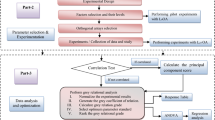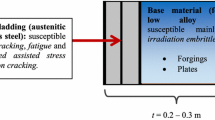Abstract
This study develops a systematic algorithm for optimizing the multi-response quality characteristics in complementary metal-oxide semiconductor (CMOS) ion implantation experiments in terms of overall product quality, by adopting the grey situation decision-making method. Finally, the feasibility and effectiveness of the proposed algorithm is demonstrated by such an experiment.
Similar content being viewed by others
References
Lin CL, Lin JL, Ko TC (2002) Optimization of the EDM process based on the orthogonal array with fuzzy logic and grey relational analysis method. Int J Adv Manuf Technol 19:271–277
Lin CT, Chen CB, Chang CW (2002) Screening synchronously occurred multiple abnormal quality characteristics screening in a silicon wafer slicing process. Asian J Qual 3(1):48–60
Su CT, Tong LI (1997) Multi-response robust design by principal component analysis. Total Qual Manage 8(6):409–416
Chang CY, Sze SM (2000) ULSI devices. Wiley, New York
Tai CY, Cheu TS, Wu MC (1992) An enhanced Taguchi method for optimizing SMT Process. J Electr Manuf 2:91–100
Taguchi G (1986) Introduction to quality engineering. Asian Productivity Organization, UNIPUB, New York
Wang H, Chen R, Ding X (2001) Grey situation decision with comprehensive sample matrix. J Grey Syst 2:147–152
Antony J (2000) Multi-response optimization in industrial experiments using Taguchi’s quality loss function and principle component analysis. Qual Reliab Eng Int 16:3–8
Deng J (1999) Grey system theory and applications. Kao-Li, Taiwan
Pignatiello JJ Jr (1993) Strategies for robust multi-response quality engineering. IIE Trans 25:5–15
Lin JL, Tarng YS (1998) Optimization of the multi-response process by the Taguchi method with grey relational analysis. J Grey Syst 10(4):355–370
Tong LI, Su CT (1997) The optimization of multi-response problems in the Taguchi method. Int J Qual Reliab Manage 14:367–380
Phadke MS (1989) Quality engineering using robust design. AT&T Bell Laboratories, Prentice Hall, New Jersey
Logothetis N, Haigh A (1988) Characterizing and optimizing multi-response process by the Taguchi Methods. Qual Reliab Eng Int 4:159–169
Reddy PBS, Nishina K, Babu AS (1997) Unification of robust design and goal programming for multi-response optimization. Qual Reliab Eng Int 13:371–383
Chen SH, Chou JH, Li JJ (2002) Optimal grey-fuzzy controller design for a constant turning force system. Int J Mach Tools Manuf 42:343–355
Hao Y, Cheng L (1997) The application of grey situation decision to the selection of afforestation species in loess plateau. J Grey Syst 1: 75–81
Ma Y, Su Z, Ma G (1996) Grey decision making on vegetable production. J Grey Syst 2:189–196
Author information
Authors and Affiliations
Corresponding author
Rights and permissions
About this article
Cite this article
Lin, CT., Chang, CW. & Chen, CB. A simple approach to solving multi-response quality characteristic problems in CMOS ion implantation. Int J Adv Manuf Technol 28, 592–595 (2006). https://doi.org/10.1007/s00170-004-2396-9
Received:
Accepted:
Published:
Issue Date:
DOI: https://doi.org/10.1007/s00170-004-2396-9




